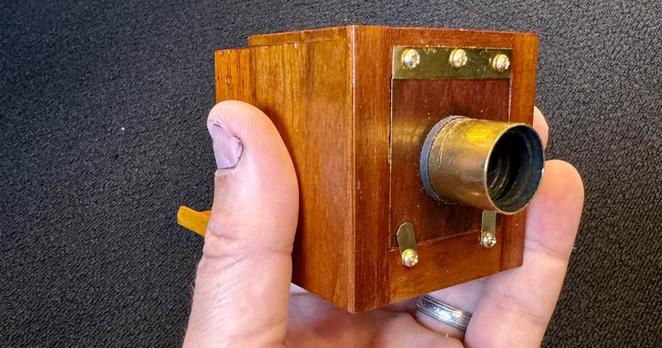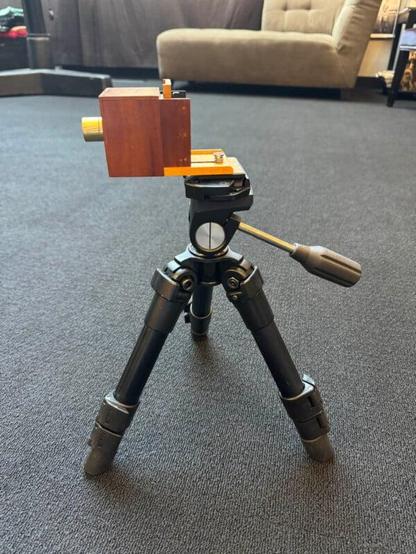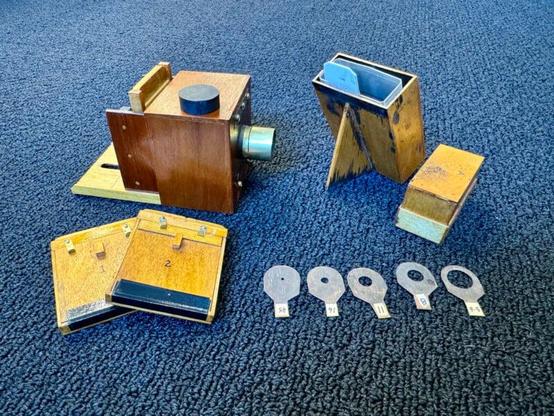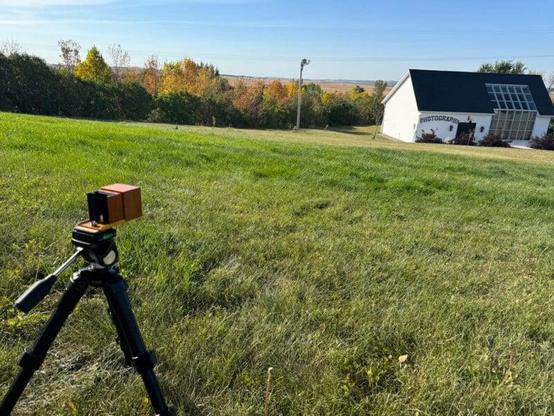Shane Balkowitsch: smaller is better, my tiny #wooden #WetPlate camera https://zorz.it/tWCCd | #ShaneBalkowitsch #camera #miniature #tiny #WetPlateCamera #WetPlateCollodion #equipment #WalkThroughs #features
#wetplatecamera
Smaller is Better: My Tiny Wooden Wet Plate Camera https://petapixel.com/2024/10/08/smaller-is-better-my-tiny-wooden-wet-plate-camera/ #wetplatecollodion #shanebalkowitsch #wetplatecamera #Walkthroughs #Equipment #miniature #Features #wetplate #camera #tiny
Bill Hao Is Confident We Can Love Old School Photography Techniques
#photographyculture #landscapephotographer #landscapephotography #largeformatcamera #largeformatfilm #largeformatlens #largeformatphotographer #largeformatphotography #outdoorphotographer #outdoorphotography #selfmadecamera #ultralargeformat #wetplate #wetplatecamera #wetplatecollodion #wetplatecollodionprocess #wetplatelandscapes #wetplatephotographer #wetplatephotography #wetplatephotographyproject #wetplateportraits
Bill Hao Is Confident We Can Love Old School Photography Techniques
#photographyculture #landscapephotographer #landscapephotography #largeformatcamera #largeformatfilm #largeformatlens #largeformatphotographer #largeformatphotography #outdoorphotographer #outdoorphotography #selfmadecamera #ultralargeformat #wetplate #wetplatecamera #wetplatecollodion #wetplatecollodionprocess #wetplatelandscapes #wetplatephotographer #wetplatephotography #wetplatephotographyproject #wetplateportraits
Wet Plate Pictorialism in the Modern World: ‘Maiden Pouring Milk’
The Accademia del Disegno (“Academy of Design”), which opened in 1563 Florence, Italy was the world’s first academy of art. Prior to that time, to succeed with a career in the arts, a would-be artist either apprenticed in a respected Master’s atelier or was self-educated.
The underlying principle of a Renaissance painter or sculptor’s education was to copy the works of his or her Master, as well as the work of historical Greek or Roman artisans. Through the replication of contemporary or classical works, the student was given the opportunity to explore established techniques and subject matter, while simultaneously developing his own vision and style. To use a current metaphor in today’s language: Amateurs borrow, professionals steal.
Vermeer - The Milkmaid 1658
One of the more famous photographic "steals" was by the Pictorialist photographer William Mortensen, whose 1938 photograph "Servant Pouring Milk" was created based on Jan Vermeer’s 1657 painting "The Milkmaid."
William Mortensen - Maid Servant Pouring Milk 1938
Fast forward to 2021 Bismarck, North Dakota, and enter the only natural light wet plate studio built in over 120 years. Ask to see the black glass wet plate of "Maiden Pouring Milk" by contemporary collodion Pictorialist Shane Balkowitsch.
Having no previous experience in photography, Shane was intrigued by a portrait he saw on an online gallery in 2012. Researching the image, he discovered it was made with wet plate collodion chemistry, an 1851 process that applied pure silver onto glass or tin. Stunned by the clarity and permanence of images developed on glass plate collodion negatives some 140 years previous, Shane was captivated by the process as well as the imagery. Over nine years and 4,000 plates later, Shane has (with certain modesty) easily achieved the moniker of Master.
On a weekly basis, he continues his seminal documentation of the Northern Plains Indians, produces elegant studio and location portraits of contemporary icons (such as Greta Thunberg), and teaches students from across the country. He continuously expands and explores his creativity through self-motivated projects.
It was his study of, and respect for, William Mortensen that lead him his most recent recreation: "Maiden Pouring Milk."
In his words:
“I have always been a fan of William Mortensen. I have most of his books and have read all I can about his work and his contributions to Modern Pictorialism. Ansel Adams called him the “Anti-Christ” because of their philosophical, let alone technical differences. Despite the fact that I can appreciate a great landscape, that comment has never sat well with me. I have been aware of Mortensen’s work “The Milkmaid” for some time now. It has always drawn me in. After doing further research into his 1938 photograph I realized that I had seen this image before and figured out that a very similar scene was painted by Jan Vermeer. Further research proved that Mortensen indeed credit Vermeer as being an inspiration for him, hence my inspiration from Mortensen.
"I immediately contacted my prop master Laine Pope and sent her over images from both Vermeer and Mortensen. I explained to her that we are not going to duplicate either image exactly but make one of our own. Laine got to work on making the round pitcher by hand and then the milk from clay layered with varnish. The added challenge of getting the appearance of a liquid pouring from the decanter in a 10-second exposure was a challenge that I wanted to address.
"I thought the butchered chicken was a must for this shoot. In the Mortensen, there appears to be some sort of carcass or game bird on the table. We decided we would go with a chicken. Laine knew a local farmer and acquired the bird. Leaving the feet on was rather important to create a timeless atmosphere within the photograph. Draping the legs over the edge of the table became an important element of the composition as well.
"I needed to find our maiden. ve Lancaster has been to my studio on half a dozen occasions creating work with me. At this point, her ability to hold still under difficult 10-second exposures has become legendary. The main issue was to get the milk to appear as if it is pouring out of the pitcher. We wanted the image to be moodier and darker, so getting the exposure of her face was important as well as the shadows and mood of the rest of the scene. We spent about 3 hours in the studio accomplishing the three 10 second exposures. The 3rd plate was the one I felt was the best for what we were trying to achieve. Digital photographer, Chad Nodland, captured behind the scene images that detail the creation of the work.
"It is always so rewarding to make a scene in my studio that is believable in some sense of being from somewhere else. For me, my wet plate is successful if you find yourself looking at Eve and for a brief moment believing that maybe she is in the 16th century. Upon closer inspection, however, Eve is wearing ear gauges, a tell-tale sign that this is a modern image. I like leaving little clues in the shots that give away the image’s era."
The highest compliment an artist can receive is that of his peer’s respect and recognition. Forty-two museums worldwide have accessioned Shane’s black glass plates. And like all seminal art, the "Maiden Pouring Milk" has taken on a life of its own. Established in 1853, England’s Royal Photographic Society is the world’s greatest repository of classic and contemporary photography. The best of the three original plates was recently acquired by the prestigious RPS who, coincidentally, had given William Mortensen its coveted Hood Medal in 1949.
Shane’s work is in very good company.
_Image credits: "Maiden Pouring Milk" by Shane Balkowitch. More from Balkowitch can be found on Instagram, Facebook, and his website. _
About the author: A fourth-generation Clevelander, Herbert Ascherman, Jr. has been a professional photographer for 45 years. Herb has written numerous articles for books, journals, and photographic publications worldwide.
#spotlight #johannesvermeer #project #shanebalkowitsch #themilkmaid #wetplate #wetplatecamera #wetplatecollodion #wetplateportraits #williammortensen
This Wet Plate Photo Took the Collaboration of 90 People to Produce
For the past five years, I have organized an annual photographic Tableaux Vivant based on classic paintings. I have included anywhere from 15, or in the instance of my 2021 construction, No Vaccine for Death, 90 collaborators.
Ideas come from everywhere. Occasionally we self-generate. More often they are thrust upon us. Photographic history is certainly replete with expansive portraits. Utilizing a digital camera, group portraits can be captured quickly, in rapid succession, and at a moment’s notice.
My portraiture, however, vastly differs from the work of contemporary photographers as I turn the clock back with the use of Frederick Scott Archer’s 1851 medium of wet plate collodion, and it is thought that less than 1,000 photographers practice this archaic form of analog photography in present day. I am very proud to be one of them.
In the wet plate process, liquid collodion is poured over a piece of polished black glass, sensitized in a bath of silver nitrate, exposed in the camera, and then developed immediately (under safe light conditions), usually within minutes, as to not allow the collodion to dry on the plate and the image lost.
For location work, I have built a portable darkroom that is easily transported. All development must be done instantly and on-site. For the techies, I use an Italian Alessandro Gibellini 8×10-inch bellows studio camera mounted with a Carl Zeiss Tessar 300mm f/4.5 lens with a manual lens cap as my shutter. No Vaccine for Death was shot outside under the open haze of a Bismarck, North Dakota sky (artfully and unfortunately provided by the California wildfires) with a one-second exposure at f/11.
No Vaccine for Death is the fifth largest production that my friend, collaborator, project director, and St. Mary’s College (of Bismarck) film professor Marek Dojs and I have worked on together. Each time we start a new project, it seems we get more ambitious and attempt to push the envelope of what is, or seems to be, possible. Two years ago, our project was going to be something completely different. We had a painting of saints descending from, and people ascending to, heaven. The image personified the conflict between the ideas of good and evil.
When COVID hit, we knew we had to confront the pandemic.
With the onset of the pandemic, life, as we well know it, changed in a heartbeat.
“In regards to the theme -- one thing that I’ve been thinking a lot about is how afraid of death our society has become. The idea that we will live forever, and that pain and suffering should be avoided at all costs, has created a lot of problems in our time. The pandemic brings the possibility of death closer to us, but death is the real pandemic -- and there will be no vaccine for that -- we will all die. No Vaccine for Death might be an interesting title,” Marked said at the time.
At that point, No Vaccine for Death was born. In a meeting several days later, Marek and I discussed The Triumph of Death, Pieter Bruegel’s 1562 masterpiece which hangs in Madrid’s Museo del Prado. Inspired by the unstoppable onslaught of Europe’s Black Plague which killed over 25 million people (nearly a third of Europe at the time, and which lingered on for hundreds of years longer), our wet plate shoot could not have come at a more poignant time in modern history. The world had just started to recover from the COVID-19 pandemic.
The Triumph of Death | Pieter Bruegel| 1562 - 1563. Oil on panel
Marek and I thought that if we could immortalize this scene through our own visual vocabulary, we could possibly put COVID behind us. Marek, cognizant of our inevitable death, felt that if people focused so much time and energy on things that are not important, we would lose track of our time here on Earth. He wanted to stress the fact that there is no vaccine for mortality. In so doing, we attempted to pay homage to Bruegel’s original image.
With the concept firmly in hand, our efforts turned towards the logistics of production. Needing an open and accessible location, my first call was to Monsignor Shea, the President of the University of Mary here in my hometown of Bismarck, North Dakota. On the college grounds is the sacred Marian Grotto which formed the basis for the scene. The stone arch of the grotto was a close match to the stonework in our inspirational painting from 459 years ago.
I then enlisted the aid of Michael Stevenson and Michele Renner Oster, directors of the local (Shakespearean) theatre companies for the creation of costumes. Forty backup and support personnel, including make-up artists, hairstylists, carpenters, dressers, and armorers were pressed into action. Dozens of skeleton costumes were purchased, altered, and fitted for the various volunteers. As a matter of fact, once the call for actors went out on social media, over 100 respondents ranging from local university students to photographers from San Diego, St. Louis, and Cleveland, Ohio, asked to be part of, then joined, the collaboration.
Finally, the morning of July 21 arrived. I had barely slept. At 6:00 am, I was on-site with a flatbed pick-up truck arranging camera angles and laying out the relative positions of each of the participants. By 8:00 am, the temperature had hit 80 degrees (on its way to 100 a couple of hours later).
The intrepid actors were in full-length Renaissance costumes and ready to be placed. I estimated it would take at least eight collodion plates to get the perfect shot. Each plate would take a minimum of 30 minutes to expose, develop, and evaluate, let alone allowing the actors time to stretch, move around, grab a bottle of water, and then reset.
As it is often said, a wet plate is not taken, it is given to you. I was prepared to work until I had a satisfactory image. Fortunately, my crew was likewise committed.
I mounted the truck, double-checked the exposure, and left to coat the first plate with collodion. Marek, bull horn in hand, directed the actors to their positions.
The first plate was over-exposed.
Nailing down a precise exposure on a first attempt using natural light is always a challenge. Reset, I took another plate which I judged as adequate. It’s now an hour later and the sun has really begun to take its toll. A third plate was exposed, we were beginning to see our vision for the shot unfold. As everyone gathered around to see the results once it was washed, a cheer went up with the general agreement we were close.
We took a short break and went for our fourth and final plate of the day. All the elements we were trying to incorporate and capture became visible. We had our one plate, the plate that would represent our 18 months of planning. The final plate is being donated to the State Historical Society of North Dakota with a list of all of the collaborators that were involved.
We had something to show for our moment in the sun. A pure silver-on-glass image when properly curated will exist for hundreds if not thousands of years after we are all gone. One second of our lives immortalized as a reminder to others of our time together.
Pizza served. Champagne uncorked. Camaraderie exchanged. Congratulations were shared by all.
We were asked by the local media if this is the largest “live” wet plate collaboration of all time? To that, we had no answer or concern. We just wanted to come together for no other reason than to create as a group. The history and significance of our time together will be left up to others to determine.
No Vaccine For Death | Shane Balkowitsch
I want to thank each and every person that contributed to this fabulous adventure. I am so blessed to be on this creative path with all of you.
Editor 's note: A full list of all those involved in this production as well as a great deal more behind-the-scenes images can be viewed on Shane Balkowitsch's website.
About the author: Shane Balkowitsch is a self-taught photographer from Bismarck, North Dakota that specializes in wet plate collodion photography. He believes this process is magical because the end result is tangible and precious. His extensive work in the medium can be seen on his website. The documentary Balkowitsch details his growth from a quirky businessman in his 40s who was looking for a creative outlet and stumbled upon an archaic form of photography that changed his life's path. Eight years later, his Native American wet plate photos are being archived around the globe, and his recent portrait session with Greta Thunberg at Standing Rock Indian Reservation has been seen by millions and is in the vaults of the Library of Congress.
#editorial #walkthroughs #collaboration #lagescale #novaccinefordeath #project #shanebalkowitsch #wetplate #wetplatecamera #wetplatecollodion #wetplateportraits



